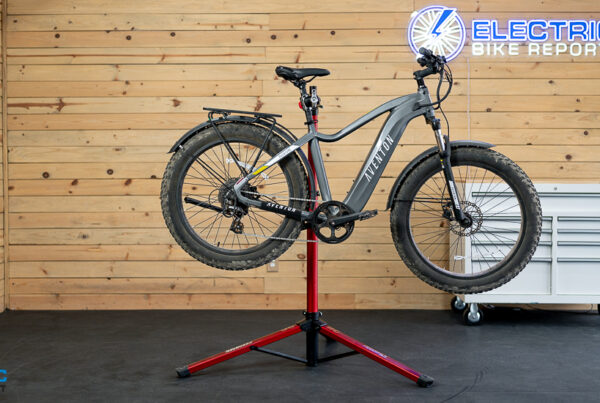Zeal Pro E-Bike Cover: Features
Designed for use in conjunction with an e-bike-capable bike rackthe Zeal Pro E-Bike Cover is a two-piece protective barrier against the elements. The bottom section of the cover can be set over the troughs of a bike rack, the bike itself can be lifted into place on the rack and secured into the troughs, and then the top section of the cover can be slid over the bike and zipped together with the lower piece.
We appreciated the heavy fabric construction of the (nearly) universal e-bike cover and its waterproof lining. The cover itself was simple to use; it took us roughly 10 minutes to envelope our first test bike, but we were able to cut that time down to about 5 minutes on later attempts. Considering that e-bikes are often heavy, the two-part design was a relief, as it did not require us to flip the bike to seal the bag’s zipper.
The cover is roomy enough to fit even some of the largest e-bikes on the market! We tried three of differing sizes to test its limits – the iGo Core Elite 3HD, the Ride1UP Riftand the Quietkat Jeep Rubicon. With its front and rear cargo racks, the Core Elite 3HD was a good test of the bag’s expandable front section; there was more than enough room to accommodate this average-sized e-bike. Our second test was the Rift, one of the largest and longest e-bikes currently in our storage area. Again, the cover handled the bike with room to spare – plus we had the chance to expand the rear cargo rack section.
The Rubicon pushed the boundaries of the Zeal Pro E-Bike Cover – and I’m not sure I’d comfortably recommend it for a bike with 780mm handlebars – but technically, it fit! The seams of the handlebar section of the cover seemed strained and it was slightly out of proper alignment, however, so I might suggest limiting the handlebar width to something more modest. Discovering details like this is why we do what we do!
Zeal Pro E-Bike Cover: Bottom Line
Without significantly increasing cost, I’m sure that it would be difficult for Zeal to truly make a one-size-fits-all cover, but I was amazed by how close their e-bike cover came to meeting that goal. The cover won’t cut it for extremely long cargo e-bikes like the Lectric XPedition, or decked-out beach cruisers with moustache handlebars like the Electric Bike Company Model S, but the vast majority of e-bikes on the market with more conventional designs should fit just fine.
Overall, I was highly impressed with the Zeal Pro E-Bike Cover’s thoughtful and intuitive design, as well as its robust weatherproof construction. It’s a functional product that is quick and easy to use, and I think it makes a lot of sense for e-bike (and traditional bicycle) riders who want to protect their investment. If you use your bike rack often to transport your e-bike across moderate or long distances and you live in areas with unpredictable weather, I think Zeal’s (nearly) universal e-bike cover is a product you should absolutely consider adding to the mix!
.
.
.
#Zeal #Pro #EBike #Cover #Review #Electric #Bike #Report
Source link









